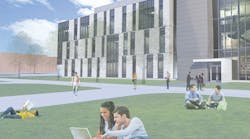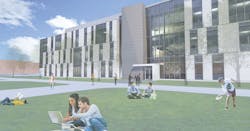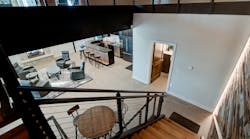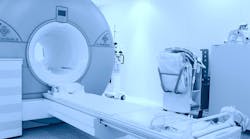Today’s college students have grown up with a focus on recycling and energy efficiency. It’s no wonder, then, that many universities are pursing Leadership for Energy Efficient Design (LEED) certification for their new campus buildings. A prime example is Farmingdale State College SUNY in Farmingdale, N.Y., which is breaking ground on a new $26.7-million School of Business building that will exceed the state of New York’s energy efficiency requirements by 30%.
The team is seeking LEED silver certification through such sustainability features as energy-efficient lighting, mechanical, and electrical systems. When completed, the building will serve as a recruitment tool for future generations of students, says Greg Sibley, associate principal for Vanderweil Engineers’ New York office, which is responsible for the design of the mechanical, electrical, plumbing, fire protection, and IT systems for the design-bid-build project. The engineering firm is partnering with such companies as: Gordon L. Seaman, Inc., the electrical contracting firm; Stalco Construction, general contractor; Urbahn Architects, architect and interior designer; and Domingo Gonzalez Associates, lighting designer, on the project.
“A lot of colleges are finding that their students are asking them what they are doing to be sustainable,” says Sibley. “The benefit of them saving energy is that they can attract students who are environmentally conscientious. This generation is well aware of global warming, climate change, and the problems that can occur during their lifetime, and they have come to appreciate the benefit of higher efficiency buildings.”
Investing in energy-efficient equipment
While going green on the project can add about 2% to 3% to the overall cost, the college will recoup the expense through significant energy savings in the long-run, notes Sibley. For example, the college will be able to minimize heating and cooling costs through the construction of an efficient building envelope with additional insulation and high-efficiency glass.
Engineers also specified a direct digital control building energy management system, allowing the college to control the energy use within the building based on the air quality and occupancy levels. Over time, Farmingdale can review the historical data and use it to improve the operation of the building. In addition, electricians are installing variable-frequency drives (VFDs) to control motors as well as occupancy sensors that are tied into not only the lighting, but also to the HVAC system. That way, they can make classrooms slightly cooler in the winter or warmer in the summer when they’re not being used. Through the demand ventilation system, the college can also adjust the outside air ventilation.
Working in concert with the building management system, the VFDs are able to control the delivery and minimize the amount of fresh air needed and the current associated with the fans.
“Carbon dioxide sensors can trend the amount of fresh air being brought into the building,” says Dave Pinto, managing principal for Vanderweil Engineers. “They can cut back on the amount of air being delivered to certain spaces based upon student occupancy rates.”
LEDs and fluorescents light the way
Another key way the team is able to design efficiency into the project is through advanced lighting technology. LED luminaires, which require less maintenance and save energy, are taking off in the industry, Pinto says.
“They produce much more light for less energy,” Sibley says. “They also have a longer life, and they don’t need to be changed as often. This is especially important on college campuses, where budgets may be cut back and their maintenance staff is asked to do more work with less people.”
Domingo Gonzalez, president of Domingo Gonzalez Associates, says the most important green features on the building go well beyond LED lighting. In his view, one of the biggest aspects of LEED compliance is reducing total watt per square foot levels to harvest points under the Energy and Atmosphere category. For this project, the ASHRAE code limit is 1.2, and the lighting came in at 0.83 while still achieving mandated lighting criteria.
“Overall, we are hitting a home run when it comes to lighting power density and wattage per square foot,” says Gonzalez, explaining that the lighting designer specified two main types of luminaires — LED, which comprises less than 10% of the total lighting scheme and fluorescent T5 units.
“Everyone thinks LEDs are the most energy-efficient lighting technology available, but T5 fluorescents are also highly efficient and extremely cost effective,” says Gonzalez. “On this project, the real workhorse was the 28W T5 fluorescent lamp.”
Along with the fluorescent and LED luminaires, the building will also take advantage of available light through daylight harvesting. Rosemarie Seeland, lighting designer for Gonzalez Associates, says that every T5 fluorescent luminaire that is within 15 ft of a window has an integral daylight control. Also, the atrium and stairs have photocells as well as selective switching capabilities.
Gaining efficiency through lighting controls
Lighting controls also play a significant role in the pursuit for LEED certification. All private offices, conference rooms, and classrooms are controlled with combination occupancy sensor wall switches. In public bathrooms, the team is installing occupancy controls and time clocks to alternately control two banks of luminaires to illuminate walls. After midnight, only half the lights will come on when the occupancy sensor is activated. A similar approach is implemented in the stairwells, where one lamp is wired to the panel, while the other is wired to an integral occupancy sensor. That way, the stairs are never dark, but only half the lamps are on when not in use.
“Lighting controls play an enormous role in any sustainability effort,” says Gonzalez. “Having controls is a smart investment in a project’s sustainable future.”
By investing in energy-efficient equipment and the latest luminaires and control technology, the College of Business will be able to not only save energy costs, but also educate its students about the importance of going green.
Fischbach is a freelance writer and editor in Overland Park, Kan. She can be reached at [email protected].




